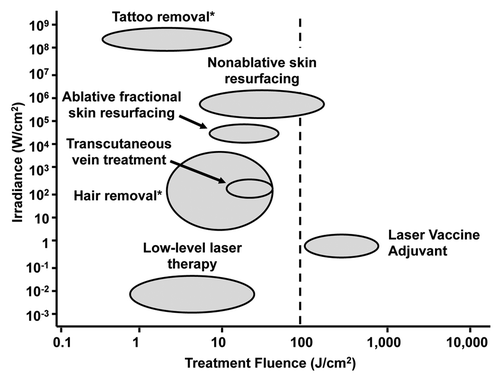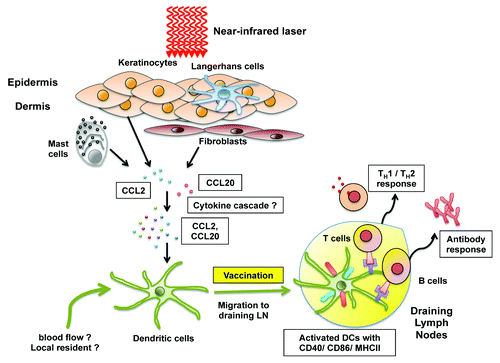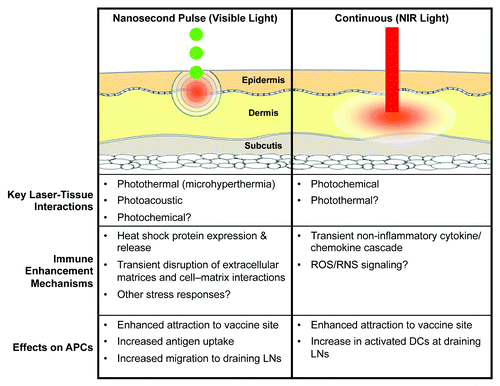Figures & data
Figure 1. Comparison of the typical irradiances and fluences for laser dermatology procedures. A plot of irradiances vs. fluences for dermatologic applications of lasers is shown. Note that parameters of LVA are quite distinct from those of other applications. *Data represents single pulse treatment on a specific skin target.

Table 1. Comparison of laser parameters used in different LVA studies
Table 2. Preclinical study of laser adjuvant
Table 3. Clinical study of laser adjuvant
Figure 2. Putative mechanisms of action of NIR laser adjuvant. Non-tissue damaging continuous wave (CW) near-infrared (NIR) 1064 nm laser given in short exposures to small areas of the skin is able to augment broad immunity including antibody, TH1 and TH2 immune responses to vaccination. NIR laser adjuvant stimulates the expression of a defined set of cytokines and chemokines including CCL2 and CCL20 (via undefined molecular mechanisms) that ultimately induce functional and migrational changes in DCs in the skin. Figure courtesy of Eugene L.Q. Lee (Imperial College London).

Figure 3. Absorption spectrum for major skin chromophores and the optical window. Light absorption in the skin is wavelength dependent. In the UV to near infrared portion of the spectrum, the predominant tissue chromophores are hemoglobin, melanin, and water. The absorption coefficients for both melanin and hemoglobin decline significantly after 600 nm and water does not increase significantly until after 1200 nm. This creates an “optical window” at red and near-IR wavelengths that maximizes penetration of light into the skin. Note that the 1064 nm NIR laser adjuvant is within the window whereas 510/578 or 532 nm pulsed laser adjuvants are not. Hb, hemoglobin; HbO2, oxygenated hemoglobin. Figure courtesy of Dr Michael Hamblin (Massachusetts General Hospital).

Figure 4. The distinctions between pulsed and continuous wave laser vaccine adjuvants. There are 2 major types of laser vaccine adjuvant (LVA). Each class of LVA has a distinct mode of laser-tissue interaction, mechanisms of action, and the effect on antigen presenting cells (APCs). NIR, near-infrared; ROS, reactive oxygen species; RNS, reactive nitrogen species; DC, dendritic cell; LNs, lymph nodes.

